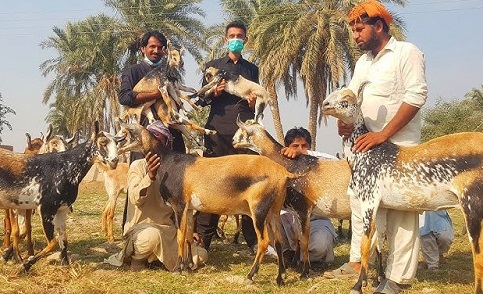What’s Happening In Karachi-Pakistan? HIV Cases Rising Exponentially And More Incidences Of Drug Resistant HIV Infections Emerging!
Nikhil Prasad Fact checked by:Thailand Medical News Team Jun 18, 2024 10 months, 2 days, 11 hours, 56 minutes ago
HIV News: Karachi, Pakistan's bustling financial hub, has been grappling with a significant increase in HIV cases over the past two decades. With a population exceeding 17 million, Karachi has become a focal point for understanding the spread and genetic diversity of the human immunodeficiency virus type-1 (HIV-1). The city's HIV-1 epidemic is complex, involving various subtypes and drug resistance mutations that pose challenges for treatment.
 HIV Cases Rising Exponentially in Pakistan And More
HIV Cases Rising Exponentially in Pakistan And More
Incidences Of Drug Resistant HIV Infections Emerging!
Rising HIV Cases and Diversity
In recent years, the number of HIV cases in Karachi has surged. The first cases were reported in 1987, and since then, the epidemic has grown significantly. According to the Sindh province HIV/AIDS epidemiology database, Karachi had the highest number of HIV-1 cases in 2021, with 6,768 reported cases, 40% of which were in the central district alone. This increase was claimed to be primarily associated with people who inject drugs (PWIDs), among whom the HIV prevalence is alarmingly high at 48.7%. (For the sake of political correctness, we shall refrain from detailing out what is really occurring!)
Study on HIV-1 Genetic Diversity and Drug Resistance
A comprehensive study that is covered in this
HIV News report, was conducted to understand the genetic diversity of HIV-1 and identify drug resistance mutations among people living with HIV in Karachi. The study involved 364 HIV-positive individuals with a median age of 36 years. Blood samples were collected, and the HIV-1 partial pol gene was successfully sequenced from 268 individuals. This gene sequencing allowed researchers to generate phylogenetic trees to determine the diversity of HIV subtypes and assess drug resistance mutations.
Diverse HIV-1 Subtypes in Karachi
The study revealed 13 distinct HIV-1 subtypes and recombinant forms circulating in Karachi. The most common subtype was A1, accounting for 40% of the cases, followed by CRF02_AG (33.2%). Other subtypes, such as C and various recombinant forms, were also identified. This diversity indicates that Karachi is experiencing a wide range of HIV-1 strains, complicating efforts to manage the epidemic.
Drug Resistance Challenges
One of the critical findings of the study was the high prevalence of drug resistance mutations (DRMs) among people living with HIV in Karachi. Among ART-experienced patients, 30.6% had DRMs, with 70.7% showing resistance to non-nucleoside reverse transcriptase inhibitors (NNRTIs), 20.7% to nucleoside reverse transcriptase inhibitors (NRTIs), and 8.5% to protease inhibitors (PIs). In ART-naïve patients, 5.6% had DRMs, predominantly associated with NNRTIs.
Implications for Treatment
The high prevalence of DRMs in ART-experienced patients poses significant challenges to the effectiveness of antiretroviral therapy (ART). Resi
stance to NNRTIs was particularly high, with mutations like E138A and K103N being common. These mutations reduce the effectiveness of drugs such as efavirenz and nevirapine, which are part of the standard ART regimen in Pakistan. Consequently, patients with these mutations are at risk of treatment failure, leading to poorer health outcomes.
Importance of Continuous Surveillance
The study underscores the need for continuous HIV molecular epidemiology and drug resistance surveillance. Regular monitoring can help identify emerging DRMs and guide the selection of effective ART regimens. This approach is crucial for ensuring the long-term success and sustainability of the ART program in Karachi and other regions with similar challenges.
Key Findings and Future Directions
-HIV-1 Genetic Diversity: Karachi's HIV-1 epidemic involves 13 distinct subtypes, with A1 and CRF02_AG being the most common.
-Drug Resistance: High levels of DRMs were found in both ART-experienced and ART-naïve patients, particularly against NNRTIs.
-Treatment Implications: The presence of DRMs threatens the effectiveness of current ART regimens, necessitating continuous surveillance and tailored treatment strategies.
-Public Health Strategy: Ongoing surveillance and targeted interventions are essential to manage HIV effectively in Karachi and similar high-risk areas.
Conclusion
Karachi's HIV-1 epidemic is marked by significant genetic diversity and a high prevalence of drug resistance mutations. These factors complicate treatment efforts and highlight the need for robust surveillance systems. By continuously monitoring HIV genetic diversity and drug resistance patterns, healthcare providers can better tailor treatments to ensure effective viral suppression and improve outcomes for people living with HIV. This study serves as a crucial reminder of the dynamic nature of the HIV epidemic and the importance of adapting public health strategies to meet evolving challenges.
The study findings were published in the peer reviewed journal: Viruses.
https://www.mdpi.com/1999-4915/16/6/962
For the latest
HIV News, keep on logging to Thailand Medical News.
Read Also:
https://www.thailandmedical.news/news/japanese-scientists-sounds-alarm-about-the-spread-of-the-hiv-1-crf01-ae-strain-in-indonesia-and-beyond
https://www.thailandmedical.news/news/japanese-scientists-sounds-alarm-about-the-spread-of-the-hiv-1-crf01-ae-strain-in-indonesia-and-beyond
